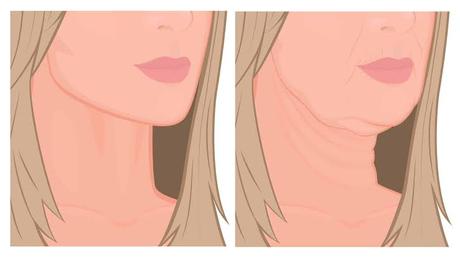When you start to lose your defined jawline, it starts to show your true age. Yet this process usually occurs gradually, so it is not always easy to notice in yourself.
What Causes Saggy Jowls?
There are two lines just below the nose, known as nasolabial folds. These folds become a lot more pronounced as we age. The reason this happens has to do with fat loss in the face that occurs naturally with age. As you start losing volume in your cheeks, everything starts to slide down. You will start to notice a droopy jawline and more wrinkles.
Do Facial Exercises Work For Jowls?
If drooping jowls were a problem with the muscles, then exercises would definitely help. You can use Jawzrsize – jawline exercise ball, to get a toned jawline. Jawzrsize can be helpful to you only at the initial stages of your saggy jowls. But jowls are caused by a loss of elasticity and volume (fat). So, trying to strengthen the muscles below your chin will not correct the actual cause of the issue.
You can compare your face muscles and skin to baggy pants covering muscular legs. Doing more lunges and squats won’t make a difference to how your pants look since you are still wearing baggy pants. So, the answer to sagging jowls is to either tighten the skin or add volume.

Is There A Way To Prevent Loose Jowls?
Saggy jowls occur naturally. As you start getting older, your skin will begin to loosen. You may even be genetically predisposed, so look at either your grandmother or mother to get an idea where you might be headed without any interventions. If jowls bothers you a lot then one of the best strategies to stop your jowls from drooping or sagging is to stay on top of tightening problems and invest in treatments like fillers as you start to age.
If you are looking for an effective treatment for your jowls without having to undergo invasive surgery, today, there are many non-surgical treatments to consider. But it is completely your choice to go for it. Many of these techniques are designed to improve the appearance, lift, and tighten your jowls.
1. Filler Injections
Dermal fillers are injections that are effective in reducing noticeable aging signs, mainly in the jowls and facial areas. As people start to age, their skin loses thickness, collagen, and elasticity. This is what causes your skin to start losing its tight appearance, which eventually leads to a drooping or saggy look. Today, there are many dermal fillers made for jowls, which include:
- Calcium Hydroxylapatite (CaHA)
- Hyaluronic Acid (HA)
- Polymethylmethacrylate (PMMA)
- Calcium Hydroxylapatite (CaHA)
- Poly-L-lactic Acid
- Autologous fat injections
These filler injections return a youthful appearance and fullness to the jawline, chin, and saggy neck for droopy jowls. Choosing the right injection site and the appropriate filler can break of make how efficient these treatments are. Injections are typically outpatient procedures along with minimal recovery and preparation time. However, results are only temporary, and one or more repeat treatments are usually required.
2. Ultrasound Therapy Or Ultherapy For Collagen Stimulation
Ultherapy is a non-surgical, cosmetic, outpatient procedure for firming, tightening, and lifting jowls. Similar to filler injections, Ultherapy is easy and fast. The treatment causes no to very little discomfort and involves very little to no recovery downtime. Ultherapy has also received FDA approval to treat sagging jowls to tighten and lift the skin tissue and muscles.
Ultrasound therapy stimulates collagen production in the skin. After treatment, the skin will have a higher collagen level and will be more elastic, firmer, toned, and smoother. Some of the main benefits of ultrasound therapy are that it is chemical-free and all-natural. Like dermal fillers, the results of ultrasound therapy may last, but it is still only temporary.
3. Radiotherapy
Radiotherapy is a treatment to tone and tighten the jowls, which works on similar principles to ultrasound therapy. These treatments encourage the production of elastin and collagen. Radiotherapy causes the skin to think it is damaged, which causes a “healing reaction.” The results from this “pseudo-healing” process cause the skin to look more youthful and tighter.
Unlike ultrasound therapy and dermal fillers, radiotherapy treatments for jowls involve undergoing many sessions to start noticing favorable results. This treatment is effective in fighting against drooping jowls. However, the downtime associated with these treatments is a setback for certain patients.
4. Neck Tightening With eMatrix
eMatrix is one of the gentler options to tighten the neck and safer and more suitable when compared to CO2 lasers for the skin that can cause pigmentation. More advisable for neck tightening, eMatrix uses radio-frequency that resurfaces the skin. The heat involved in these treatments encourages collagen production and promotes smoothing effects without the risks associated with laser therapies.

Can You Reduce Your Risks Of Developing Jowls?
You might develop jowls due to factors you cannot control. However, there are still many things you should be doing to stop your jowls from drooping prematurely.
- Avoid Or Stop Smoking – Chemicals in tobacco or cigarettes can cause damages to your skin.
- Stay Out Of The Sun – Always apply sunblock to your neck and face before you leave home. Try and make it a regular morning routine. This will help to lower the damages caused by UV rays.
- Limit Screen Time – Focus on keeping a comfortable and natural angle for your head when you use a phone or computer to stop the skin on your neck from stretching out or becoming bunched up. It is also possible to protect your neck muscles by taking a 5 to 10-minute break every hour after doing computer work.
Final Thoughts
Today there are many solutions and options for concealing, treating, and even preventing jowls when you are embarrassed or not happy with them. Make sure that you first consult with a doctor or dermatologist to discuss the best solution for you. This is even more important if you are over the age of 60 or have a condition that may increase the risks of complications. It is also advisable to read up on reviews about the different treatment options to better understand what to expect.
**Sponsored Content**
